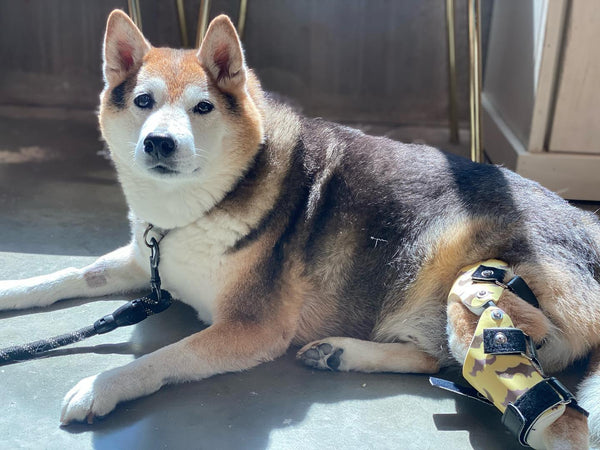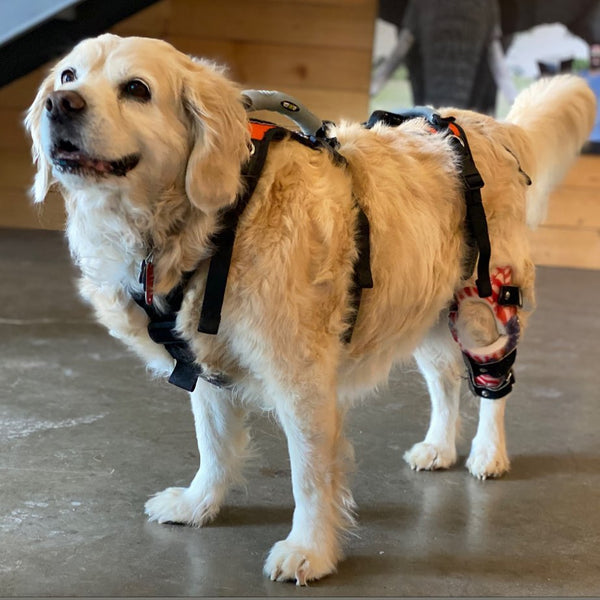Newsflash: even the best-behaved dog can sometimes injure itself. A tumble can leave your pup with a swollen, painful knee that needs extra help healing. In other cases, it's just age affecting your dog’s bones.
If this is true for your pet, a knee brace can relieve their pain. But before going ahead and buying a knee brace, you must ensure that the item fits your dog well.
Casting your dog for a knee brace is critical to keeping your best buddy safe from further injury. This process may appear difficult at first, but it's much easier than you think.
In this blog, we provide the materials and steps to measure dogs for a knee brace without hurting them.

First of All, Why Would Your Dog Need a Knee Brace?
At some point in a dog’s life, it may experience joint pain, instability, and other knee problems. This can be from an injury, arthritis, or other health issues. Naturally, as a dog parent, you will do anything to help your pup be as comfortable as possible. That’s where a knee brace comes in.
Leg braces for dogs provide support and stability. They commonly treat partial CCL or ACL tears, stabilize the knee, reduce pain, and facilitate scar tissue formation.
Furthermore, knee braces are cost-effective when you are uncomfortable putting your dog through expensive surgery.
If any of these symptoms sound familiar, but you're unsure of the cause, contact a specialized vet for a definitive diagnosis.
Once you have a professional diagnosis and the vet recommends a knee brace, it's time to cast your dog.

Time to Gather the Items You Will Need for the Task
To accurately measure your dog, you will need the following items included in your Bionic Pets’ casting kit:
- Fiberglass casting tape
- A cut strip
- A pair of gloves
- A stockinette
- A clever cutter
- A pair of scissors
- A helper
- Your dog!
Step by Step of What You Need to Do
Step One: Cover Your Dog’s Entire Leg with the Stockinette
The stockinette protects your dog's fur and skin from the casting tape, ensuring their comfort during the procedure. It functions like a regular sock, making covering your dog's leg easy. Avoid it being too tight or loose. A helper can hold it in place during casting.

Step Two: Prepare the Casting Tape
Your casting kit comes with two different-sized rolls of casting tape. The amount of tape needed will depend on your dog's size. Smaller dogs may only need one roll, while bigger dogs will likely need both. At Bionic Pets, we recommend starting with the larger roll to cover as much area as possible from the beginning.
Before using the casting tape, remember a few things:
- Wear gloves, as the casting material is sticky and leaves residue.
- Be cautious of your dog's fur since the tape can stick to it.
- Once you remove the casting tape from the package, you have about 3 to 5 minutes before it completely hardens. So, only take it out when you're ready to use it.
After opening the casting tape package, dip the tape in water for about 3-5 seconds and ring the water out completely.

Step Three: Wrap the Casting Tape Around Your Dog’s Leg
Place the cut strip on the front of the leg and bend your dog's knee at a 45-degree angle. Start wrapping the tape just above the hock.
The hock is the small joint located below the knee, resembling a bump or protrusion. It is similar to a human ankle joint.
Wrap the tape a few times above the hock to secure the fiberglass, then wrap it an inch below and move back up. Continue wrapping until you reach the groin, ensuring the cut strip stays in place.
Step Four: Repeat the Same Process with the Second Roll
If you need to use the second roll, repeat the same steps as above. Start wrapping just above the hock and then about an inch down. Continue wrapping up the leg until you reach the groin and until you finish the roll.

Step Five: Squeeze the Mold at the Knee As It Dries
This is not mandatory, but it helps get a more accurate mold and a better-fitting brace.
Try to squeeze the mold with two fingers at the sides of the knee joint. At the same time, with your other hand, squeeze higher, around the thigh, with two fingers.
Step 6: Take the Mold Off
Position the clever cutter at the top of the mold, aligned with the cut strip. Then, cut down the cut strip until you reach the bottom.
You will usually not achieve a clean cut on the first attempt. So, repeat the process until you cut through the length of the mold.
Next, remove the cut strip and pull out the cast along with the stockinette.
Before you ship your mold to Bionic Pets, we suggest noting your dog's name and the casted leg with a marker.
Bionic Pets: Empowering Your Furry Friend's Recovery Process with Custom Braces
A good cast is the key to the perfect brace for your pet. After completing the casting process, send your mold back to Bionic Pets. Our current turnaround time is about 4-5 business days after receiving the cast, but timelines are subject to change.
With over two years in the industry, at Bionic Pets, our main mission is to help animals regain mobility. Our most popular items are our custom-made braces that come in different sizes, shapes, and colors.
We understand the importance of having a properly fitting brace for your dog's comfort and safety. That’s why we use only high-quality materials and provide personalized attention to each pet's needs. If you have any questions or concerns about the fit of the brace, feel free to contact us. We will assess pictures and videos to see if we need to make any adjustments.
Help your dog recover from injury and regain mobility with Bionic Pets’ custom knee braces. Visit our website to order your custom knee brace today.
How to Help a Dog With a Strained Muscle
How Much does a Prosthetic Leg for a Dog Cost?
